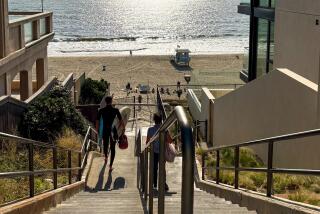Memories Linger on Boardwalks
- Share via
ATLANTIC CITY, N.J. — For more than a century, millions of Easterners have made summer pilgrimages to the ocean boardwalks of the Jersey shore, an institution romanticized in song and memories of saltwater taffy.
When people consider the boardwalks along the state’s 127 miles of Atlantic coastline, they generally think of the first in the world, erected in 1870 in Atlantic City to reduce the amount of sand tracked into shops and hotels.
In reality, 26 cities and towns have wooden beach walkways, which today seem more popular than ever. Indeed, there is hardly a Jersey seaside community without one, or without shops and taffy, “rolling chairs”--wicker chairs set on wheels and pushed--or without amusement parks.
“People keep coming to the Jersey shore from all over the East Coast because we have some of the best bathing beaches in the world,” said Mark Soifer, a municipal spokesman for Ocean City. “And the boardwalks have always been part of the beach scene.”
As vacationers’ thoughts turn to warmer weather, ambitious plans are being made for a $350-million redevelopment project on the 2 1/2-mile boardwalk at Asbury Park, 60 miles south of New York City.
A contract has been signed with pop singer Michael Jackson and his family for construction of the Jackson Family World Showcase Pavilion, a center described by David Roberts, Asbury Park’s director of planning, as “dedicated to the music recording industry, with an auditorium for performances and a museum of Jackson family memorabilia.” No construction date has been set.
Negotiations also are under way to construct two other major pavilions on the Asbury Park boardwalk, a Cousteau Society ocean center and a Ringling Brothers space exploration pavilion, Roberts said.
Other recent additions to the state’s boardwalks include a convention center built three years ago at The Wildwoods, where weekly summer concerts feature music ranging from rock ‘n’ roll to military bands. Water parks have been erected on several other walks in the last few years, the latest at Ocean City.
Perhaps no more romantic vision of the boardwalks has ever been spun than the 1960s Drifters’ classic “Under the Boardwalk,” in which they crooned, “We’ll be falling in love/Under the boardwalk.”
More than a decade later, rock guitarist Bruce Springsteen, who grew up in Freehold, N.J., helped launch his superstar career from the boardwalk and beach at Asbury Park. Before he became famous, Springsteen spent much of his time playing in boardwalk bars like the Stone Pony and the Upstage Club, and he refers in several songs to boardwalk characters like Madame Marie, the fortune teller of Asbury Park.
Perhaps the biggest boost to boardwalks came in 1976, when casino gaming in Atlantic City was approved, sparking a renaissance of development all along the shore and attracting 33 million visitors annually.
Ten huge casino-hotels have opened on the Atlantic City walk at a cost of $5 billion, helping to make the city the top tourist destination in America. The newest is Donald Trump’s 42-story Taj Mahal, opened last April 2, which cost $1 billion and is bigger than 2 1/2 football fields.
Traditional celebrations have been taking place on New Jersey boardwalks ever since the first Easter parade was held on Atlantic City’s walk in 1876.
Mothers parade on Mother’s Day, fathers on Father’s Day at Seaside Heights. At Ocean City, there are an annual baby parade, a freckle contest and a suntanning tournament with prizes for such entries as the best suntan on a bald person and the best left-arm tan for people who drive a lot.
Fireworks, art shows, band concerts and marathons also are popular on the walks in the summer--and national beauty pageants began in Atlantic City in 1921 with the Miss America contest.
In winter, boardwalks traditionally have been “ghost” walks, with shops and amusement piers shuttered until the crowds reappear. In winter there are often more sea gulls and pigeons than people on the wooden planks.
But not all of those who tread the walks are warm-weather visitors. Bag ladies and homeless men have lived under the boardwalk at Atlantic City for years.
“We continually relocate the homeless to shelters, but for many of them, the space under the boardwalk is the only home they know,” veteran Atlantic City policeman John Lee said.
Each town with a boardwalk has special maintenance crews constantly replacing planks tramped upon by millions of feet, weathered by glaring sunshine and salt air, and blasted apart during ocean storms, severe northeasterlies and hurricanes. Life expectancy for a plank, not counting storm damage, is about 10 years.
“Some of the seashore communities experimented unsuccessfully, replacing wooden planks with aluminum, but people don’t like it. They like the sound and feeling of wood under their feet,” boardwalk historian Blair W. Learn said.
Now, the seashore walkways may expand to Florida: Disney World plans a boardwalk. Which one are officials of the giant entertainment complex studying? The queen of them all, of course, the 121-year-old boardwalk at Atlantic City.
More to Read
Sign up for The Wild
We’ll help you find the best places to hike, bike and run, as well as the perfect silent spots for meditation and yoga.
You may occasionally receive promotional content from the Los Angeles Times.






